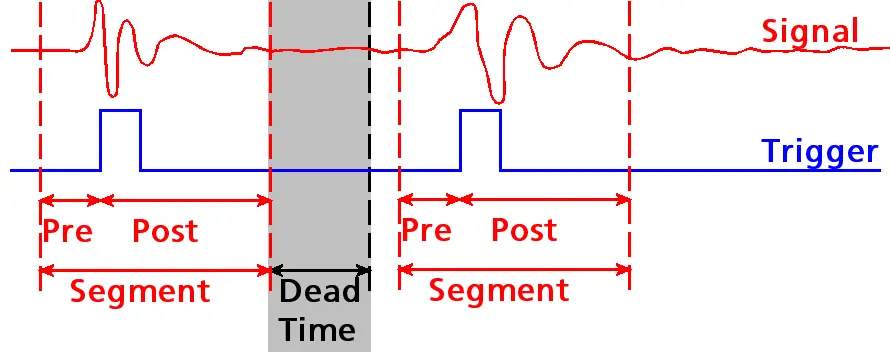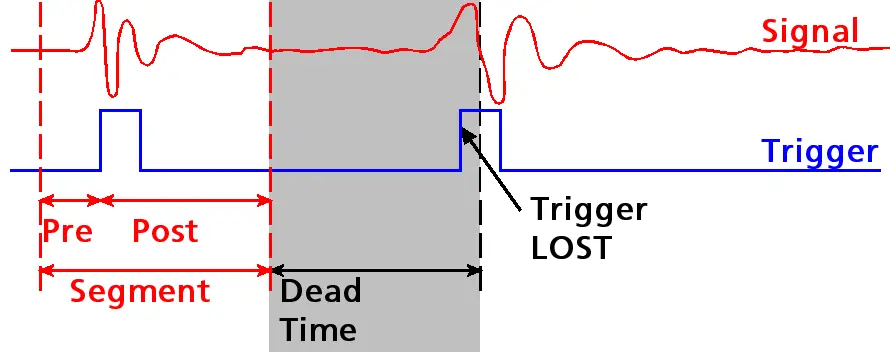-
Comparisons
-
Hardware Features
-
Systems
-
Software
-
Company
Knowledge-Base
- Hardware Features
- Acquisition Modes
Repetition Rate
Before selecting a digitizer for fast repeating signals one needs to calculate from the digitizer specifications whether it is possible to reach the desired repetition rate. The key figures for these calculations are the repetition rate of the source signal, the specified dead time of the digitizer, the sampling rate and the minimum segment length and step size of the segment length. All figures (except the source signal) are found in the data sheet of the digitizer.
How does the dead time influences the repetition rate
The dead time (or re-arm time) is the time the trigger engine and the digitizer needs to arm the trigger detection again and to be ready for the next segment acquisition. The dead time is specified for segmented acquisition modes like Multiple Recording (fixed segment length), Gated Sampling (varying segment length controlled by gate signal) and ABA mode (fixed segment length with two time bases).

The right picture shows a fast repeating pulse signal that where every pulse is acquired because the dead time after the acquisition of one segment is small enough to allow the acquisition of the next segment. During the dead time the digitizer is blind and does not recognize trigger events.
 On the right picture one sees a dead time that is too long to acquire this fast pulses. The digitizer is still blind when the next trigger is there and the second segment of data is not acquired. In such a case either the repetition rate of the source signal has to be slower or the digitizer dead time has to shorter. The dead time on all Spectrum digitizers is given in samples. A higher sampling rate then automatically leads to smaller dead time while some other manufacturers specify the dead time as fixed time figure. There going to higher sampling rates has no influence on the reach repetition rate.
On the right picture one sees a dead time that is too long to acquire this fast pulses. The digitizer is still blind when the next trigger is there and the second segment of data is not acquired. In such a case either the repetition rate of the source signal has to be slower or the digitizer dead time has to shorter. The dead time on all Spectrum digitizers is given in samples. A higher sampling rate then automatically leads to smaller dead time while some other manufacturers specify the dead time as fixed time figure. There going to higher sampling rates has no influence on the reach repetition rate.
How to calculate the repetition rate (example for slow card)
To calculate the maximum possible repetition rate one needs two figures:
- The dead time as time value. This is simply calculated from the sampling rate and the specified dead time in samples. As example, a M2p.5923-exp (20 MS/s 16 bit digitizer) has a dead time of 40 samples making 40 x 50 ns = 2 us dead time when running at 20 MS/s (100 ns)
- The acquisition length of each segment. This would be specified by you and must match the digitizer settings for minimum segment length and segment length step size. In our example, a desired segment size of 5 us (5 us / 50 ns = 100 samples) would be rounded up to 5.2 us (104 samples) as the step size of the segment length for this digitizer is 8 samples
Having these both figures one simply calculated the maximum repetition rate as 1 / (dead time + segment acquisition time). In our example this would lead to 1 / (2.0 us + 5.2 us) = 139 kHz
How to calculate the repetition rate (example for fast card)
Another example is the M5i.3360-x16 (10 GS/s, 12 Bit):
- The dead time iof this familiy is 352 samples when running with one channel, making 352 x 100 ps = 35.2 ns of dead time
- When aiming for a segment length of 50 ns (50 ns / 100 ps = 500 samples), this would be reounded to 51.2 ns (512 samples) as the step size of segment length is 32 samples
Having these both figures one simply calculated the maximum repetition rate as 1 / (dead time + segment acquisition time). In our example this would lead to 1 / (35.2 ns + 51.2 us) = 11.5 MHz